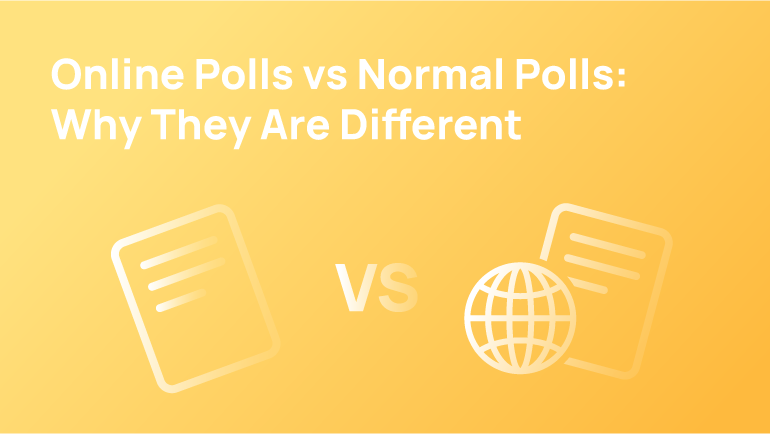
Polling is a simple and easy way to ascertain public opinion. Governments use polls, businesses, nonprofits, and academics to gauge people’s reactions to topics important to the community. They can help them gain insights into what their customers want and where they should focus their marketing efforts. Comparing the opinions of different groups is also a way to see if the opinions of certain groups are changing over time.
With today’s media advancement and the internet’s entrance into our daily lives, polling methods have progressed. With the introduction of online polls, polling methods have breathed new life into their industry.
They now offer a variety of ways to conduct an opinion poll and offer people a platform to voice their thoughts on any given subject, which is at par with the current digital trend.
How do they differ from regular polls?
What are Online and Normal Polls, and How do They Differ?
Polls have been around for decades, but they have become more prevalent. In most cases, they are conducted to get a sense of how the public feels about an issue or whether or not a given person should be elected.
There are many different ways to conduct online polls, but they usually start with a question posed to a given audience. A poll can be used to create an online community with a common interest or simply give the public their opinion on a given topic.
On the other hand, regular polls are conducted in person and have been used for decades. They cater to other purposes, such as political polling or market research. The significant difference is how they are administered because they are conducted traditionally.
The Cons of Traditional Polls
For a good reason, traditional survey methods are being phased out. Market research was a valuable tool during its inception, but it is no longer relevant in the digital age. Particularly when compared with modern alternatives, they possess numerous disadvantages.
Traditional surveys have several drawbacks. Some of these problems include:
- A snail mail letter takes way too long to reach its intended recipient (it’s called snail mail for a reason). In addition, there is no guarantee that mail-in surveys will be opened, completed, and returned immediately. Returns may even be uncertain.
- Handwritten replies on stiff paper are more prone to smudges and smearings. The handwriting of respondents makes it challenging to read hard copy survey responses.
- Participants may hang up during phone interviews, cutting them short without warning.
- Most people treat phone surveys as spam and don’t answer them. The anonymity of the phone survey may make respondents uncomfortable.
- Surveys cannot be screened, selected, or taken only by the right respondents.
The Pros of Online Polls
Traditional survey methods have been replaced with online polls. The mail-in survey route involves hard-copy surveys, hardphone interviews, and hard-paper surveys. While these kinds of surveys were valuable in the past, they are now outdated and inferior to online surveys.
In addition, online surveys have resulted in more conveniences and positive characteristics for market research overall.
In contrast to traditional survey methods, online surveys are more convenient and easier for consumers and businesses. Several benefits include:
- The anonymity of the information despite the demographics is ensured
- Targeting and screening of participants was easy
- Cost-effective, as most providers charge per completed questionnaire
- Results are faster since digital; the survey platform receives the answers immediately. Result analysis may also be quicker and better reported and visualised.
- A higher reach or response rate is ensured since it is convenient for participants.
- There is a reduced survey bias from the “interviewer effect”.
- Participants may be incentivised.
Conclusion
Public opinion can be easily measured through polls, which are simple and easy to do. Various government agencies, businesses, nonprofits, and academics use it to gauge public opinion about issues that concern them.
There are two types of polls: online and normal. Online polls are polls that are created and run on the internet. Normal polls, on the other hand, are conducted in person. These two types are very different in terms of delivery and medium. With the advent of online polls, traditional surveys have become outdated and inferior to online surveys.


